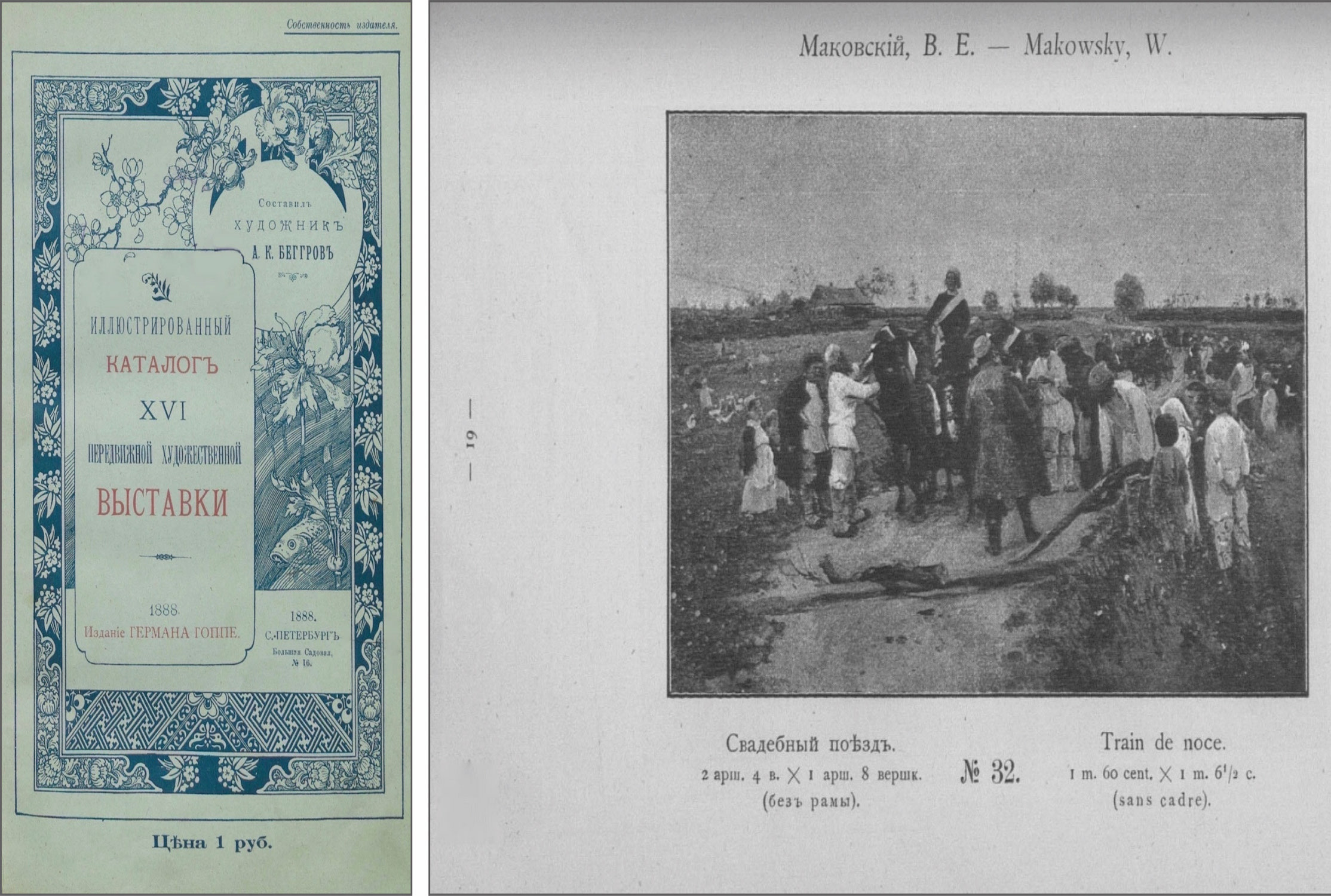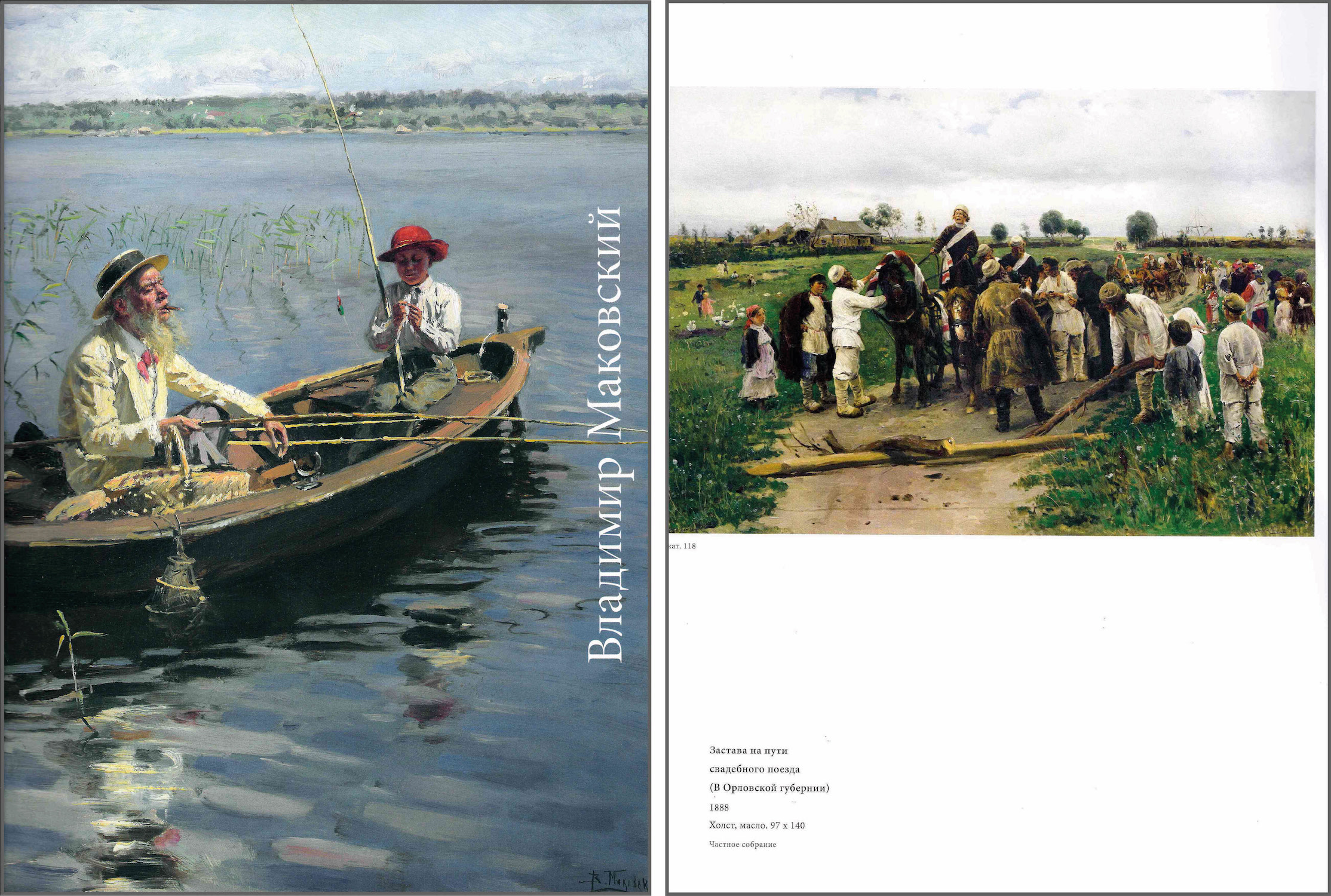Important Russian Art
1 December 2021

◎ 22. MAKOVSKY, VLADIMIR (1846–1920)
The Wedding Procession, signed and dated 1888.
Oil on canvas, 96.5 by 138 cm.
450,000–600,000 GBP
Authenticity of the work has been confirmed by the expert V. Petrov.
Authenticity has also been confirmed by the experts N. Ignatova and A. Dergacheva.
Exhibited: Possibly, XX peredvizhnaia vystavka Tovarishchestva peredvizhnykh khudozhestvennykh vystavok, St Petersburg, Moscow, Kharkov et al., 28 February 1888–5 February 1889.
Literature: E. Nesterova, Vladimir Makovsky, St Petersburg, Izdatelstvo Petronii, 2019, p. 161, No. 118, illustrated; p.161, 299, No 118, listed.
Related literature: A. Beggrov, lliustrirovannyi katalog XVI-oi peredvizhnoi vystavki Tovarischestva peredvizhnykh khudozhestvennykh vystavok, St Petersburg, Izdanie Germana Goppe, 1888, p. 19, No. 32, illustrated in black and white and listed as Svadebnyi poezd.
Zhivopisnoe obozrenie, 1888, No. 25, p. 395, illustrated.
Khudozhnik, 1889, No. 5, p. 309, illustrated.
G. Romanov, Tovarishchestvo peredvizhnykh khudozhestvennykh vystavok. 1871–1923 gg., entsiklopediia, St Petersburg, Sankt-Peterburg Orkestr, 2003, p. 113, No. 13–91, illustrated in black and white, and listed as Svadebnyi poezd.
An unmistakable recognition of the hand of an artist who is engrossed in tackling his favourite theme springs out immediately from Vladimir Makovsky’s painting The Wedding Procession.
A prominent Itinerant, and, as Vladimir Stasov, the main critic of the 19th century, put it, a major artist, one of the “best and most monumental” painters of his age, Makovsky has gone down in the history of Russian art as an inimitable master of genre painting. His canvases depict virtually the entire spectrum of the “Russian life” theme, and their vivid rustic festivities, fairs and processions form, perhaps, the most striking part of his artistic legacy.
One of them is the peasant wedding composition that is now to be auctioned. The picture was painted in the village of Selishche in Oryol Province, the home of the extensive Maslov family, with which Makovsky was on very friendly terms. From the 1870s onwards, the artist would often stay with them in the summer, together with the composer Sergei Taneyev.
Friends there used to produce a handwritten humorous magazine, Zakholustye (The Back of Beyond or Backwater) between 1876 and 1889, to which Makovsky contributed under the pseudonym “Nemrod Plodovitov”, and they would also heatedly discuss each other’s artistic projects. Taneyev and the owner of the house, Fyodor Maslov, even sat for Makovsky, posing for the paintings Prayer Service in Holy Week (State Tretyakov Gallery and the Serpukhov History and Art Museum) and Family Case Before the Magistrate (State Tretyakov Gallery).
It was here, in Selishche, that the artist witnessed the peasant wedding that inspired him to paint several large canvases. Makovsky always took great care when depicting folk scenes: they enabled him to give tangible form to his interest in the everyday life and ethnography of different areas of the country, and to record the local traditions and rituals, costumes and landscapes, as well as the many colourful human types and characters. The picturesque portrayal of a folk wedding was therefore ideal for the artist’s purposes.
In 1888, Makovsky executed several versions of The Wedding Procession, thus depicting one of the most colourful episodes in a village celebration.
The wedding procession – a line of carts led by one that accommodated the bridegroom, the groomsmen and the nuptial father – is on its way to fetch the bride from her parents’ house. It unexpectedly encounters a deliberately improvised obstacle – a log laid across the road. Men are standing beside the procession, negotiating a “ransom” or “right of free passage” in exchange for money or refreshment.
Some of the peasants are shown standing with their backs to the viewer, but, as Elena Nesterova, who has made a study of the artist’s work, rightly notes, “without even seeing the faces, literally by their posture and by small, precisely captured details, one can sense and understand the country folk’s temperament and mood” (E. Nesterova, Vladimir Makovsky, St Petersburg, 2019, p. 164). The picture features a host of characters. There is a groomsman restraining the leading horse, with its shaft bow intertwined with an embroidered red and white cloth specially for the event, which has been frightened by the unexpected crowd. The groom’s elegantly dressed companions, wearing the shoulder sash that was traditional at a wedding ceremony in the southern Russian provinces, are trying to cajole their fellow villagers. Someone is still adding a log to the road-block, others are already exchanging jokes and arguing with those taking part in the wedding procession, while someone else is already having a glass poured out for him.
Another version of this painting, with significant differences in detail, is kept at the National Gallery Prague. Makovsky would often repeat works to which the public had taken a liking. A version exactly matching the canvas that is now to be auctioned was shown at the 16th Travelling Exhibition and reproduced in the catalogue as No. 32 (Illustrirovanny katalog XVI Peredvizhnoi vystavki, St Petersburg, 1888). The size of the painting shown there is different, however. It is quite likely that the dimensions were erroneously specified in the catalogue. Either that, or we have an exact repetition of a subject much favoured by the artist.
When The Wedding Procession was displayed at the exhibition, everyone noted not only the subject, the composition and the accuracy of the everyday details, but also the special charm of the age-old Russian landscape. After all, it was largely the fusion of two genres – landscape and everyday-life – into a single whole that enabled Makovsky to give poetic expression to the image of a rustic celebration.
The evenly diffused light of a warm, but not sunny summer’s day, the greenness of the tall grass and the heads of the fading dandelions, the vastness of the sky with its dense, swirling clouds and, just visible in the background, the figures of children and geese running towards the interesting spectacle, create an atmosphere of carefree rustic life and a cheerful uplift that goes beyond the bounds of day-to-day routine.
After the exhibition, the picture proved to be so popular that it was reproduced in print repeatedly, for example, in the magazines Zhivopisnoe obozrenie (No. 25, 1888, p. 395), where the image was slightly cropped at the sides and bottom, Khudozhnik (No. 5, 1891, p. 309) and Russkaia zhizn (No. 10, 1906).
There is also one more work, titled Wedding Procession in Oryol Province, that is known from the same series, but it depicts a different, chronologically later, moment of village gaiety (1888. Plyos State Historical, Architectural and Art Museum Reserve).
Enough has been said to indicate how significant The Wedding Procession is in the artist’s creative legacy. Executed vividly, with good-natured humour and genuine attention to the details of local life, vibrant in its colour range and convincing in its depiction of the characters, this picture is a splendid example, rare in terms of its quality, of the œuvreof the outstanding Russian genre painter Vladimir Makovsky.
The present lot as illustrated in the 1888 exhibition catalogue.
The present lot as illustrated in the 2019 publication.


Notes on symbols:
* Indicates 5% Import Duty Charge applies.
◎ Indicates the lot is located in Russia. Please note that permit for export from Russia has not been obtained. Successful bidders would collect their lots in Moscow after payment.
Ω Indicates 20% Import Duty Charge applies.
§ Indicates Artist's Resale Right applies.
† Indicates Standard VAT scheme applies, and the rate of 20% VAT will be charged on both hammer price and premium.